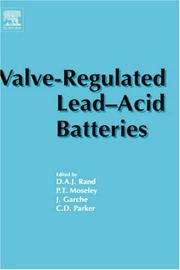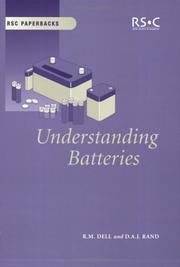| Listing 1 - 9 of 9 |
Sort by
|

ISBN: 0444507469 9786610967124 1280967129 008047473X 9780444507464 9780080474731 9781280967122 6610967121 Year: 2004 Publisher: Amsterdam Boston Elsevier
Abstract | Keywords | Export | Availability | Bookmark
 Loading...
Loading...Choose an application
- Reference Manager
- EndNote
- RefWorks (Direct export to RefWorks)

ISBN: 1280967129 9786610967124 008047473X 0444507469 Year: 2004 Publisher: Amsterdam ; Boston : Elsevier,
Abstract | Keywords | Export | Availability | Bookmark
 Loading...
Loading...Choose an application
- Reference Manager
- EndNote
- RefWorks (Direct export to RefWorks)
For many decades, the lead-acid battery has been the most widely used energy-storage device for medium- and large-scale applications (approximately 100Wh and above). In recent years, the traditional, flooded design of the battery has begun to be replaced by an alternative design. This version - the valve-regulated lead-acid (VRLA) battery - requires no replenishment of the water content of the electrolyte solution, does not spill liquids, and can be used in any desired orientation. Since the VRLA battery operates in a somewhat different manner from its flooded counterpart, considerable technol

ISBN: 9780444507464 0444507469 9780080474731 008047473X 1280967129 9781280967122 9786610967124 6610967121 Year: 2004 Publisher: Boston Elsevier
Abstract | Keywords | Export | Availability | Bookmark
 Loading...
Loading...Choose an application
- Reference Manager
- EndNote
- RefWorks (Direct export to RefWorks)
For many decades, the lead-acid battery has been the most widely used energy-storage device for medium- and large-scale applications (approximately 100Wh and above). In recent years, the traditional, flooded design of the battery has begun to be replaced by an alternative design. This version - the valve-regulated lead-acid (VRLA) battery - requires no replenishment of the water content of the electrolyte solution, does not spill liquids, and can be used in any desired orientation. Since the VRLA battery operates in a somewhat different manner from its flooded counterpart, considerable technological development has been necessary to meet the exacting performance requirements of the full range of applications in which rechargeable batteries are used. The valve-regulated design is now well established in the industrial battery sector, and also appears set to be adopted widely for automotive duty. This book provides a comprehensive account of VRLA technology and its uses. In the future, all industrial processes - including the manufacture of batteries - will be required to conform to the conventions of sustainability. Accordingly, the crucial areas of the environmental impact associated with the production and use of VRLA batteries and the recycling of spent units are also treated thoroughly. Valve-Regulated Lead-Acid Batteries gives an essential insight into the science that underlies the development and operation of VRLA batteries and is a comprehensive reference source for those involved in the practical use of the technology in key energy-storage applications. - Covers all major advances in the field. - Provides a comprehensive account of VRLA technology and its uses. - First book dedicated to this technology.
Book
Year: 1992 Publisher: Lausanne Elsevier Sequoia
Abstract | Keywords | Export | Availability | Bookmark
 Loading...
Loading...Choose an application
- Reference Manager
- EndNote
- RefWorks (Direct export to RefWorks)

ISBN: 0854046054 9781847552228 1847552226 9780854046058 Year: 2001 Publisher: Cambridge Royal Society of Chemistry
Abstract | Keywords | Export | Availability | Bookmark
 Loading...
Loading...Choose an application
- Reference Manager
- EndNote
- RefWorks (Direct export to RefWorks)
Batteries are becoming increasingly important in today's world of portable electronic devices, along with the need to store electricity derived from solar and other renewable forms of energy, and the desire to introduce electric and hybrid electric vehicles to reduce emissions. Understanding Batteries is a must for all those seeking a straightforward explanation of how batteries are constructed, their operation, and the factors determining their performance and life. Beginning with a brief history of the development of batteries and a discussion of their applications and markets, the book goes on to outline the basic terminology and science of batteries. The different types of primary (non-rechargeable) and secondary (rechargeable) batteries are then described and emphasis is given to the importance of matching the battery to the intended application. Examples are given to demonstrate how to define and prioritise the various criteria which comprise the battery specification. Throughout, the chemistry is kept as simple as possible. Understanding Batteries will appeal to a wide range of readers, including electrical equipment manufacturers and users, engineers and technicians, chemistry and materials science students, teachers and the interested battery user.
fysicochemie --- Electrical engineering --- Electrochemistry --- Electric batteries. --- Piles électriques. --- Electric batteries --- Batteries, Electric --- Batteries (Electricity) --- Cell, Voltaic --- Electrical batteries --- Electrochemical cells --- Galvanic batteries --- Voltaic cell --- Electric power supplies to apparatus --- Thermopiles
Book
ISBN: 184755055X Year: 2004 Publisher: Cambridge : Royal Society of Chemistry,
Abstract | Keywords | Export | Availability | Bookmark
 Loading...
Loading...Choose an application
- Reference Manager
- EndNote
- RefWorks (Direct export to RefWorks)
Clean Energy presents a broad survey of the energy problems facing society over the coming decades and the prospects for their solution. The book emphasizes the importance of developing a strategy for the world's future energy supply. The strategy must take into account: the finite supplies of natural gas and petroleum; the increased consumption of fuel by developing economies; the concern over greenhouse gas emissions; the pollution caused by burning coal (especially coal with a high sulphur content); the difficulties and costs of extracting unconventional fossil fuels; and the technical, soc
Energy policy. --- Renewable energy sources. --- Energy consumption --- Power resources --- Pollution prevention. --- Forecasting. --- Environmental aspects.
Digital
ISBN: 9780124046917 0124046916 9781306881050 1306881056 Year: 2014 Publisher: Oxford Academic Press
Abstract | Keywords | Export | Availability | Bookmark
 Loading...
Loading...Choose an application
- Reference Manager
- EndNote
- RefWorks (Direct export to RefWorks)
Increasing pressure on global reserves of petroleum at a time of growing demand for personal transport indeveloping countries, together with concerns over atmospheric pollution and carbon dioxide emissions, areleading to a requirement for more sustainable forms of road transport. Major improvements in the efficiencyof all types of road vehicles are called for, along with the use of fuels derived from alternative sources, orentirely new fuels. Towards Sustainable Road Transport first describes the evolution of vehicle designs andpropulsion technologies over the.
Book
ISBN: 0444637001 0444637036 9780444637031 9780444637000 Year: 2017 Publisher: Amsterdam Elsevier
Abstract | Keywords | Export | Availability | Bookmark
 Loading...
Loading...Choose an application
- Reference Manager
- EndNote
- RefWorks (Direct export to RefWorks)
Multi
ISBN: 0444637036 9780444637031 9780444637000 0444637001 Year: 2017 Publisher: Amsterdam Elsevier
Abstract | Keywords | Export | Availability | Bookmark
 Loading...
Loading...Choose an application
- Reference Manager
- EndNote
- RefWorks (Direct export to RefWorks)
Annotation
| Listing 1 - 9 of 9 |
Sort by
|

 Search
Search Feedback
Feedback About UniCat
About UniCat  Help
Help News
News